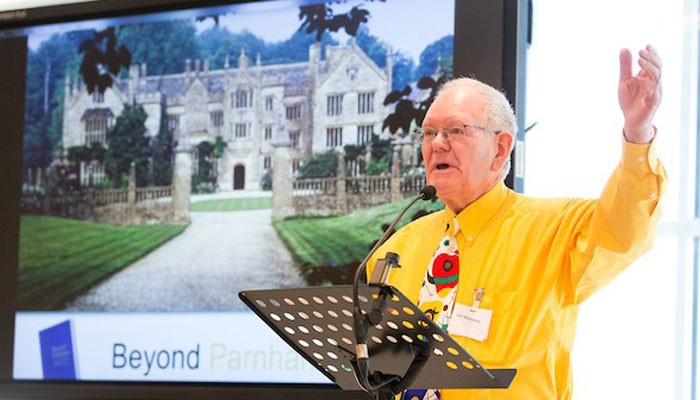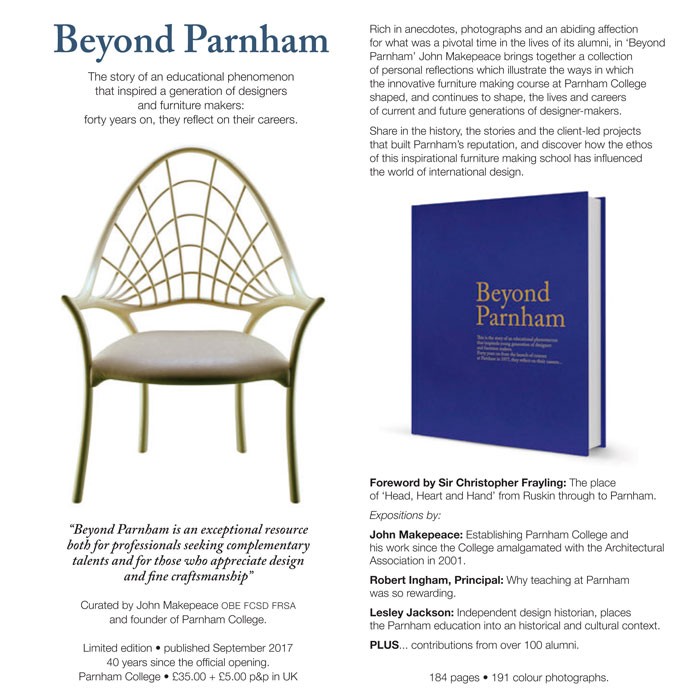Beyond Parnham
40th anniversary of Parnham College and the impact on the world of contemporary design.
September 2017 marks 40 years since Parnham College first opened its doors to students. Founded by John Makepeace OBE, this educational phenomenon turned current design and woodcraft pedagogy on its head, creating a seismic effect across international contemporary design ever since.
Celebrating the milestone anniversary, John Makepeace, winner of the 2016 Prince Philip Designers Prize, this September releases ‘Beyond Parnham’– an exclusive 180-page book detailing Parnham College’s innovative vision and cultural legacy, revealing highly personal reflections from the designer-makers and esteemed tutors who trained them.
In doing so, ‘Beyond Parnham’ illustrates how the pioneering approach taught at the College shaped the lives and careers of Parnham’s 200-strong alumni that include highly influential designers in their respective fields such as Konstantin Gric, David Linley, Sean Sutcliffe, Juliane Trummer, Jake Phipps, Verena Wriedt and many others.
Combining the art, craft and business of furniture-making in one immersive two-year residential course, Parnham College inspired an approach to design never before seen and one which ignited the careers of its illustrious alumni.
The limited-edition book weaves together the shared history that took root and the values instilled that continue to flourish across the world of contemporary design. Rich in anecdotes, photographs and abiding affection, ‘Beyond Parnham’ highlights the human-centred approach to fine craftsmanship, the spirit of the educational phenomenon that nurtured it and how the individuals were inspired with an unprecedented expression of design innovation that has shaped their careers ever since.
The teaching of fine craftsmanship, the foundations of design and the ignition of entrepreneurship were given equal educational weight at Parnham College.
Understanding the concepts of originality and innovation were at the centre of the training and John understood early how it permeates all areas, saying, ‘Original thought flows through all aspects of life. The Zeitgeist that flourished at Parnham College came from encouraging innovative thinking across all disciplines – this was the lightening in the bottle.’
Alongside this, the belief that British design and woodcraft education at the time was inadequate to enable a generation of successful designer-makers to push the boundaries of the medium, formed the philosophical cornerstone of Parnham College.
The integrated triadic approach to study enabled students to thrive in practice; it gave them the theoretical and artistic skills, the practical knowledge of the medium of wood and the business acumen to support themselves and make a living from their work.
The impact on the world of contemporary design is proven through the work of illustrious alumni such as Sean Sutcliffe of Benchmark, Konstantin Grcic, Wales & Wales, Sarah Kay, David Linley, Nina Moeller and many others. Of her experience as a Parnham student in 1996, Sarah Kay, who formerly ran an award-winning design partnership with another graduate Andrea Stemmer and now works independently, says, ‘A high percentage of my year were in our late 20s/early 30s and had left different careers behind. In terms of my being a woman, it made no difference whatsoever, we were all treated the same. Parnham was extraordinary.’
The success of Parnham College also hinged in a great part on the formidable tutors and dedicated staff that worked there. Esteemed alumnus David Linley, furniture maker and chairman of auction house Christie’s UK, puts this influence in no uncertain terms when he states, ‘I owe my career to the many people who John Makepeace brought together to revitalise the modern Arts & Crafts Movement.’ These included the notable principal Robert Ingham – a driving force at the College and tutors such as Greg Powlesland, Alan Deal, Guy Martin, Andy Christian and Chris Rose.
Of his own experience, Powlesland, who originally came to Parnham to give a guest lecture on ancient North American woodwork and later took up the post of design tutor, said, ‘Teaching highly motivated and fascinatingly diverse students was a privilege – an education for student and tutor alike.’ Former head of student house, Judith Russill echoes this: ‘Coming to Parnham was a revelation and education – my eyes were opened to the joy and excitement of beautifully designed and crafted furniture.’
Guest speakers were essential to the students’ continued learning. In Makepeace’s view: ‘Radical innovation stems from research and the cross-fertilisation between different spheres of knowledge.’ To this end, leading designers, artists and makers were regularly brought in to give lectures. The range of speakers, such as Step Haiselden who introduced the students to the basics of engineering and Paul Spooner, who made automata, played amajor part in the Parnham College narrative.
With nearly 22 years’ experience at the interface of industrial design and design strategy for companies like Boeing and IBM, Juliane Trummer is a prime example of the success of this multi-disciplinary strategy and the reach of Parnham College’s influence beyond woodcraft. Now VP of Strategy and Design at Mormedi, she credits Parnham as the basis for the many things she has been able to do in her career: ‘Its pedagogy based on self-motivation made me feel like finally being in the right place’.
Parnham House has 14 acres of grounds (and sadly has recently been in the headlines due to the devastating fire), was not the right location for John’s longer term plan to further enable student learning.
Inspired by his growing interest in forestry fostered by his friendship with the head forester of Longleat, John McHardy, he wanted to re-integrate the growing of wood with its sustainable use. John believed ardently that the potential of wood as a material had been severely neglected: ‘Apart from its environmental credentials, wood too often is regarded as having had its day rather than being a material of the future.’
He continued, ‘As a student I learnt traditional methods of construction, which had changed little over two centuries. The rebel in me could not accept these constraints were still relevant.’
In 1983 he was able to buy Hooke Park for the practical application of design and craftsmanship to create a new educational campus. This 350-acre forest, four miles from Parnham, became a centre for research and education reuniting science and art with a renewable resource. Here students learnt to understand the nature of forest produce in order to design and manufacture structures and products that exploited its best properties.
The buildings for the new campus expertly demonstrated this and a team of structural engineers, architects, material scientists and chemists were bought together to work on a series of pan-European research projects, leading to the development of new technologies for the improved utilisation of thinnings. The finished structures married material science and sophisticated engineering to inventive architecture and traditional craft skills producing a significant influence on the design of landmark edifices around the world ever since.
In 2016 John Makepeace won the Prince Philip Designers Prize in recognition of his work as a designer and outstanding contribution to the industry. John also received an OBE in 1988 for services to furniture design, the Lifetime Achievement Award from the Furniture Society (USA) in 2002, the Society’s Award of Distinction and the first Lifetime Achievement Award from the Worshipful Company of Furniture Makers.
John Makepeace continues to create fascinating work. Having completed a set of seven ceremonial chairs in 2016 for Plymouth University graduations and more recently exclusive commissions for Rosaline and Henry Wong in Hong Kong and a major legal practice in Malibu, John Makepeace Furniture also works in series, where a theme is developed in each piece, a good example is the ‘Flow’ set of four chest-of-drawers, all made from the same tree of ripple ash, one of the few uses of wood featured in the momentous V&A exhibition, ‘The Power of Making.’
Long term, John plans the sponsorship and endowment of a national educational initiative for young designers.
John Makepeace says of his work, ‘As an artist, designer and maker, I seek to devise solutions that connect an organic renewable material to physical and psychological needs.’ His award-winning work represents a meeting of classic and modern, embodying craftsmanship of the highest standard. Each piece of furniture, stand-alone or as part of a collection, is highly original and quintessentially English: He continued, ‘I am constantly searching for more eloquent concepts for furniture. My objective is to achieve freer, lighter, stronger and more sculptural forms expressed in each unique commission.’
John Makepeace will be exhibiting Trine at PAD, 8th Oct.








